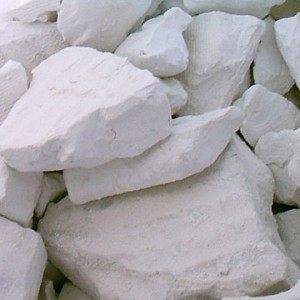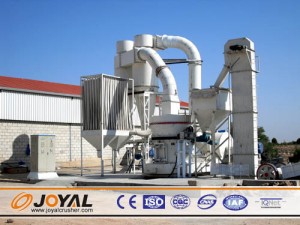

 The kaolin particle is not the finished products, what we need is kaolin powder. Usually the powder is 100-800 mesh, 1250 mesh, and 4000 mesh. In order to get them, we need use kaolin mill to grind kaolin particle into powder.
The kaolin particle is not the finished products, what we need is kaolin powder. Usually the powder is 100-800 mesh, 1250 mesh, and 4000 mesh. In order to get them, we need use kaolin mill to grind kaolin particle into powder.
There are several types of kaolin mill used in kaolin grinding process.
Ball mill for kaolin is the common grinding mill in kaolin production line, it is used for coarse grinding, the finished size is 0.074-0.4 mm, and the capacity is larger than other kaolin grinding mill.
Raymond mill is another common kaolin mill; the finished particles have a good uniformity of finess, with passing screen rate as high as 98%.
Kaolin clay generally means a particle less than 0.002mm and/or group minerals known as clay minerals. In order to get kaolin clay, we must use ultrafine grinding mill to grind kaolin particle. The ultrafine grinding mill is mining equipment which produces thin powder and super thin powder. It is suitable to non-flammable and non-explosive materials with Moh’s hardness less than 9 and humidity under 8%, such as calcite, chalk, limestone, dolomite, kaolin, bentonite, talcum, talc, magnesite, illite, pyrophyllite, vermiculite, sepiolite, attapulgite, rectorite, diatmite, barite, gypsum, alum earth, fluorite, variscite, potash ore, floatstone.
Kaolin Basics
Clay means different things to different industries.
The use and application of clay denotes the meaning. To the soil scientist and the geologist the word clay generally means a particle less than 0.002mm and/or group minerals known as clay minerals.
VSI Advantages and benefits
The Joyal VSI excels in processing this type of mineral in partly weathered granites. As the granites weather, kaolin clays are formed.
When utilising the Joyal VSI as a preferential crusher the clay, feldspar and quartz components of weathered granite can be separated. This is due to the different rates of weathering of each of the components. Quartz, being a durable mineral, takes longer to weather than feldspar and the quick weathering minerals that form kaolin.
The Joyal VSI can be placed as a pregrinder of the calcined clay before entering the ball mill. This reduces the mill feed and the subsequent energy consumption of the mill.
Kaolin clay Processing
Where clay is formed from the weathering of silica rich rocks such as granite and gneiss, it occurs with feldspar and quartz. The clay is separated from the other constituents by washing with water cannons and the slurry is then centrifuged to remove 75% of the minus 0.002mm fraction. Clay is also processed to remove any contaminating materials such as iron, aluminium quartz and feldspar. It is dried and fired to produce molochite and then fed into a ball mill. Various product gradations can be produced.
Kaolin clay Uses
The uses of clay are varied, depending on the type and markets available. The paper industry relies on clay as both as a coating and as a filler. The traditional home of clay is in ceramics where china clay has become synonymous with high quality pottery. The use today has expanded to include ceramics ranging from sanitary ware to bone china, floor and wall tiles to electrical porcelain.
To a lesser extent, clay is used as refractories, in fiberglass and in portland cement Once the clay is heated to over 500 C it becomes calcinated, forming calcined kaolin. This product has a distinctive crystal structure providing enhanced brightness and opacity.
Kaolin beneficiation process
During kaolin clay beneficiation process, Joyal can supply kaolin crusher, kaolin grinding mill, kaolin clay roller mill, kaolin clay belt conveyor and so on. The ball mill is key equipment for regrinding. It is widely used for the cement, the silicate product, new type building material, fire-proof material, chemical fertilizer, black and non-ferrous metal, glass, ceramics and etc. Our ball mill can grind ore or other materials that can be grinded either by wet process or by dry process.
 Joyal grinding mill machines can grind kaolin clay easily to get need final products. Raymond mill is applicable to the grinding and processing of more than 280 kinds of non-flammable and non-explosive materials with hardness less than 7 and humidity less than 6% in mining industry. Other related kaolin clay grinding mill or kaolin mill are vertical kaolin clay mill, kaolin ball mill, super thin kaolin grinding mill and so on.
Joyal grinding mill machines can grind kaolin clay easily to get need final products. Raymond mill is applicable to the grinding and processing of more than 280 kinds of non-flammable and non-explosive materials with hardness less than 7 and humidity less than 6% in mining industry. Other related kaolin clay grinding mill or kaolin mill are vertical kaolin clay mill, kaolin ball mill, super thin kaolin grinding mill and so on.
Kaolin mining
In the kaolin mining process, crushing is the first step. Using the crushing plant, we get kaolin particle, then using the grinding plant with one type of kaolin mill, we get kaolin powder. Kaolin clay is formed from the weathering of silica rich rocks such as granite and gneiss, it occurs with feldspar and quartz. The clay is separated from the other constituents by washing with water cannons and the slurry is then centrifuged to remove 75% of the minus 0.002mm fraction. Clay is also processed to remove any contaminating materials such as iron, aluminium quartz and feldspar. It is dried and fired to produce molochite and then fed into a ball mill. Various product gradations can be produced.
The uses of kaolin clay are varied; the most using area is paper making industry. The paper industry relies on clay as both as a coating and as a filler. The use today has expanded to include ceramics ranging from sanitary ware to bone china, floor and wall tiles to electrical porcelain.
To a lesser extent, kaolin clay is used as refractories, in fiberglass and in portland cement. Once the clay is heated to over 500 C it becomes calcinated, forming calcined kaolin. This product has a distinctive crystal structure providing enhanced brightness and opacity.